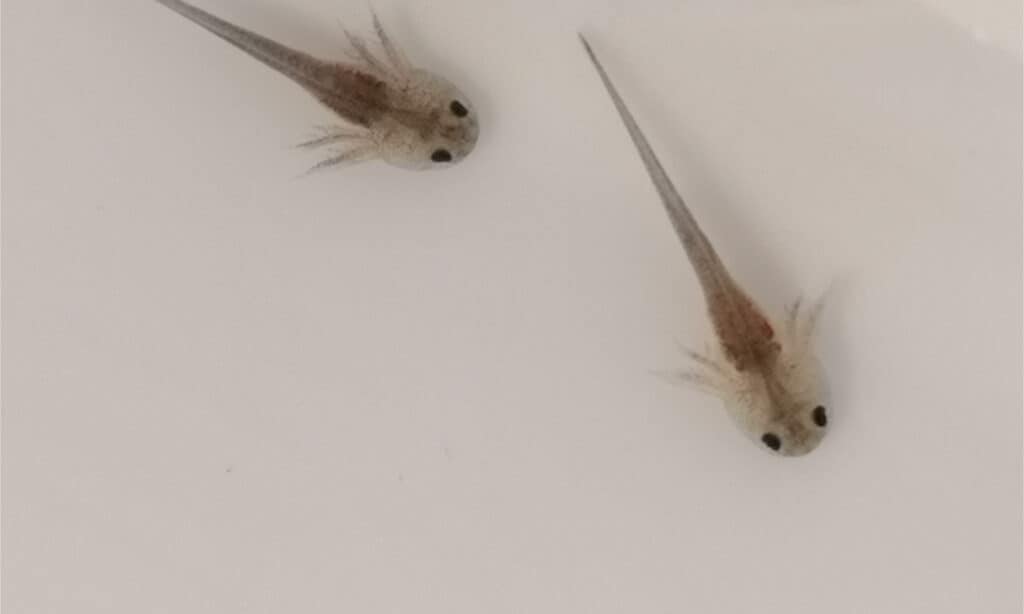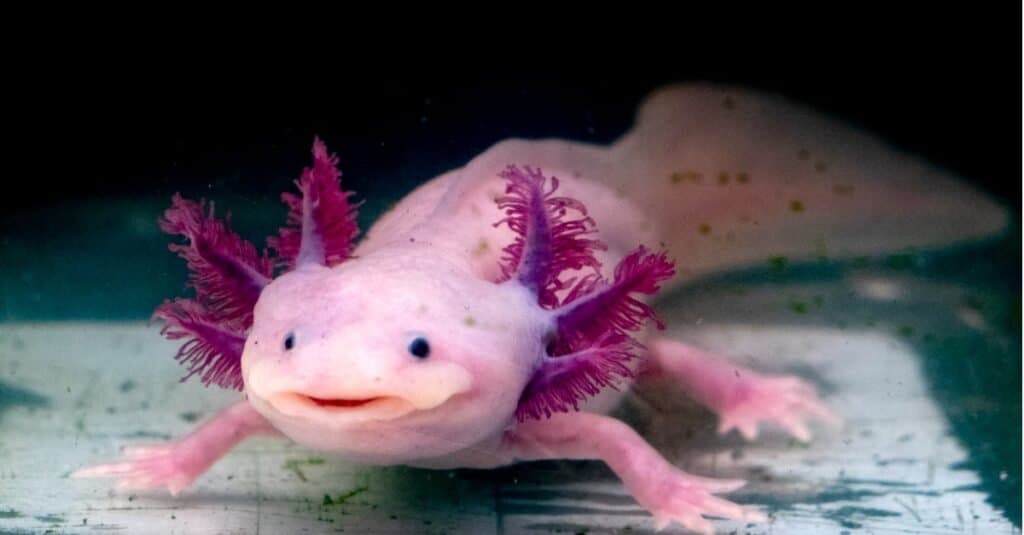Popularly known as walking fish, axolotls are members of the tiger salamander species. Unlike other salamanders, they are entirely aquatic. They like to spend their time hiding under plants or rocks at the bottom of the water. Apart from their flat heads and variation in colors, they have several remarkable qualities.
One of these is their ability to regenerate several parts of their bodies, including their spine and brain. They also have permeable skin, meaning that they absorb oxygen through their skin. This article will answer how big axolotls get, details about their growth span at different stages, their lifespan, and how to care for these exotic pets.
Where Do Axolotls Come From?
The axolotl is native to Mexico’s valley. Initially, they lived in lakes Chalco and Xochimilco, although they can only be found in the lake Xochimilco region now. Unfortunately, the population of this salamander species is no longer what it used to be. In fact, they have been added as a category of endangered species by the International Union for the Conservation of Nature (IUCN). Still, many zoos across the United States have exhibits where you can see them up close.
Unlike other salamanders, axolotls keep both their lungs and gills when they reach maturity. So, they can breathe underwater, and spend their entire lives in it. This fact is a little confusing as it lives to wonder what they really are. Is it a fish or a salamander? It’s still a salamander albeit one with special powers. They can regrow their limbs or other injured body parts.
How Big are Baby Axolotls?

Born as eggs, baby axolotls are around 0.5 inches long.
©rachata klahan/Shutterstock.com
Baby axolotls are born as eggs, whose larvae are usually about 0.5 inches long.
Grown females lay between 100 to 1000 eggs in each spawning. Each egg is laid individually and typically hatches after 14 days. Axolotl larvae begin eating as soon as they are a few hours old. Those who are between their third month till the first year are called juveniles.
How Big are Fully Grown Axolotls?

Though axolotls are known to grow as long as 18 inches, their average length is 9 inches.
©iStock.com/izanbar
Most fully grown axolotls grow to about 9 inches. This is the average length of most axolotls, even though they are known to grow as long as 18 inches.
They do not grow longer than 6 inches in some instances, while others grow up to 9 inches. The size of each salamander can be affected by its environment. Unlike other salamanders, they do not grow out of their larval form.
This is because they have the unique ability to retain their larval stage throughout their entire lives. This trait called Neoteny allows them to maintain both gills and lungs to live in water for the rest of their lives.
Once they become fully grown, it is easier to identify males from females. This is because the males develop a swollen cloaca while females have wider bodies. This width increase gives room for eggs since females can lay up to 1000 eggs!
How Long Until an Axolotl is Fully Grown?

One of the most common colors of artificial axolotls is golden albino.
©iStock.com/Trebor Eckscher
Axolotls reach their full growth size between their first eighteen to twenty-four months.
This is a wide range because other factors affect how quickly they grow. The conditions of their habit and how well they eat can shorten or lengthen this growth period. Also, the size of the tank can hinder them from growing bigger. When juveniles are moved to bigger spaces, it gives them room to grow larger.
Usually, the females take longer to mature than the males. Although juveniles have been known to attain sexual maturity within five to six months, their bodies keep growing till it reaches full maturity much later.
Are Axolotls Good Pets?
Yes, axolotls make excellent pets. Indeed, they aren’t very interactive because they prefer to be left alone. However, they have many endearing qualities that make them good companions, even if all you do is watch or observe.
While in captivity, axolotls can live as long as 15 years. Their colors are also varied, such as red, green, brown, and even olive tan. Although they aren’t big on swimming, their colorful appearance makes a fantastic addition to any aquarium.
Axolotls have what you could call a resting smiley face. And although they can be shy, you can hold them in your arms occasionally. Altogether, they are effortless to care for. Who doesn’t want a self-healing pet?
How to Ensure That Your Axolotl Grows to its Maximum Size
Even though axolotls can grow up to 18 inches, most pets are only 9 inches long. Juveniles increase in size as they grow older, and some of them can be larger or smaller than the known average size. There’s hardly anything you can do to make these pets extremely large. Instead, you can set their environment and nutrition to encourage them to grow to full maturity. This species of salamander completes its growth cycle within its first two years. So, any efforts to ensure that they grow to their full size must be made within this period.
Now, many things can determine how well your salamander grows, including the size of its tank and water temperature. While growing, it adapts to the size of its tanks. If the tank is small, it will adapt to fitting in that space as it grows in age. So, even baby axolotls need spacious tanks, giving them enough room to grow and increase. The need for space is even more necessary if you own more than one.
Axolotls thrive in their native habitat- the Xochimilco Lake, where the temperature is about 60 – 65 degrees Fahrenheit. This shows that keeping a check on the water parameters in the tank is essential. The temperature, PH, nitrate, and ammonia levels should be kept in healthy conditions.
Finally, axolotls are carnivorous and need a steady protein supply to stay healthy and grow properly. A healthy diet of axolotls includes salmon pellets, white worms, and blood worms. You must, however, be careful not to overfeed them as it would affect their health adversely. Here is a complete list of what axolotls eat.
The photo featured at the top of this post is © Eric Isselee/Shutterstock.com
Thank you for reading! Have some feedback for us? Contact the AZ Animals editorial team.






